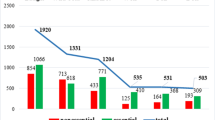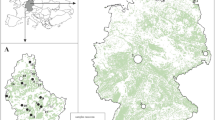Abstract
Levels of lead, cadmium, mercury, chromium, and manganese were measured in the hair of opossum (Didelphis virginiana) from Palo Verde, Guanacaste, Costa Rica. This area has some agriculture, but is slated for extensive water development that will increase ecosystem exposure to a variety of agricultural chemicals. Metal levels were generally not inter-correlated except for chromium and lead, chromium and cadmium, and cadmium and lead. There were significant gender differences only for lead and chromium, with the significantly smaller females having higher levels. It is suggested that hair from mammals, particularly abundant ominivores may be useful, bioindicators of environmental quality over a long time period.
Similar content being viewed by others
References
Al-Shahristani J, Shihab KM, Al-Haddod JK (1976) Mercury in hair as an indicator of total body burden. Bull Witt (Suppl) 53:105–112
Berg W, Johnsels A, Sjostrand B, Westermark T (1966) Mercury content in feathers of Swedish birds from the past 100 years. Oikos 17:71–83
Borg K, Wanntorp H, Erne MK, Hanko E (1968) Mercury poisoning in some Swedish wildlife. J Appl Ecol 3 (Suppl):171–172
—, Nisbet ICT, Gochfeld M (1992) Metal levels in regrown feathers: assessment of contamination on the wintering and breeding grounds in the same individuals. J Toxicol Environ Health 36:327–338
Burger J, Gochfeld M (1991a) Cadmium and lead in common terns (Aves Sterna hirundo): Relationship between parents and eggs. Environ Monit Assess 16:251–258
—, — (1991b) Lead, mercury, and cadmium in feathers of tropical terns in Puerto Rico and Australia. Arch Environ Contam Toxicol 21:311–315
—, — (1992) Heavy metal and selenium concentrations in black skimmers (Rynchops niger): Gender differences. Arch Environ Contam Toxicol 23:431–434
—, Rodgers JA Jr, Gochfeld M (1993) Heavy metal and selenium levels in endangered wood storks Mycteria americana from nesting colonies in Florida and Costa Rica. Arch Environ Contam Toxicol 24:417–420
Clark DR Jr (1979) Lead concentration: Bats vs. terrestrial small mammals collected near a major highway. Environ Sci Technol 1979:338–341
—, Ogasawana PA, Smith GJ, Ohlendorf HM (1989) Selenium accumulation by raccoons exposed to irrigation drain water at Kesterson National Wildlife Refuge, California, 1986. Arch Environ Contam Toxicol 18:789–794
EPA (1980) Ambient water quality criteria for arsenic. U.S. Environmental Protection Agency, Washington DC (NTIS 81–117327).
--EPA (1981) Interim methods for sampling and analyses of priority pollutants in sediments and fish tissue. US Environmental Protection Agency, EPA 600/4-81-055, Cincinnati, OH
Furness RW, Muirhead SJ, Woodburn M (1986) Using bird feathers to measure mercury in the environment: Relationship between mercury content and moult. Mar Pollut Bull 17:27–30
Francis PC, Birge WJ, Roberts BL, Black JA (1982) Mercury content of human hair: A survey of dental personnel. Toxicol Environ Health 10:667–672
Gardner AL (1983) Didelphis marsupialis. In: Janzen DH (ed) Costa Rican natural history. Univ of Chicago Press, Chicago, IL, pp 468–469
Gill DE (1988) A naturalists' guide to the OTS Palo Verde Field Station. Organization for Tropical Studies, Durham, NC
Goede AA, deBruin M (1984) The use of bird feathers as a monitor for metal pollution. Environ Pollut A 37:287–308
—, — (1986) The use of bird feathers for indicating heavy metal pollution. Environ Monit Assess 7:249–256
Honda K, Yamamoto Y, Kato H, Tatsukawa R (1987) Heavy metal accumulations and their recent charges in southern Minke Whales Balaenoptera acutorostrata. Arch Environ Contam Toxicol 16:206–216
—, Tatsukawa R, Itano K, Miyazaki N, Fajiyam T (1983) Heavy metal concentrations in muscle, liver and kidney tissue of striped dolphin, Stenella coeruleoalba, and their variations with body length, weight, age and sex. Agric Biol Chem 47:1219–1228
Katz SA, Katz RB (1992) Use of hair analysis for evaluating mercury intoxication of the human body: A review. Appl Toxicol 12:79–84
Kershaw TG, Clarkson TW, Dhahir PH (1980) The relationship between blood levels and dose of methylmercury in man. Archiv Environ Health 35:28–36
Klaverclamp JF, Hodgins DA, Lutz A (1983) Selenite toxicity and mercury-selenium interactions in juvenile fish. Arch Environ Contam Toxicol 12:413–442
Ma W, Denneman W, Faber J (1991) Hazardous exposure of ground-living small mammals to cadmium and lead in contaminated terrestrial ecosystems. Arch Environ Contam Toxicol 20:226–270
NRC (1978) An assessment of mercury in the environment, National Research Council, National Academy Press, Washington, DC
— (1991a) Monitoring human tissues for toxic substances. National Research Council, National Academy Press, Washington, DC
— (1991b) Animals as sentinels of environmental health. National Research Council, National Academy Press, Washington, DC
Phelps RW, Clarkson TW, Kershaw TG, Wheatley B (1990) Interrelationship of blood and hair mercury concentrations in a North American population exposed to methylmercury. Arch Environ Health 35:161–168
Reilly C (1990) Metal contamination of food. Elsevier Applied Science, London
Skaare JU, Markussen NH, Norheim G, Haugen S, Halt G (1990) Levels of polychlorinated biphenyls, organochlorine pesticides, mercury, cadmium, copper, selenium, arsenic and zinc in the harbour seal, Phoca vitulina in Norwegian waters. Environ Pollut 66:309–324
Snyder WS, Cook MJ, Nasset ES, Karhausen LR, Howells GP, Tipton IH (1975) International Commission of Radiological Protection: Report of the Task Group on Reference Manual. ICRP Publ 23, NY
Winneke G, Brockhaus A, Collet W, Kramer U, Krause C, Thron HL, Wagner HM (1985) Predictive value of different markers of lead-exposure for neuropsychological performance. In: Proc int conf on heavy metals in the environment, Athens—1985. World Health Organization, Geneva
Author information
Authors and Affiliations
Rights and permissions
About this article
Cite this article
Burger, J., Marquez, M. & Gochfeld, M. Heavy metals in the hair of opossum from Palo Verde, Costa Rica. Arch. Environ. Contam. Toxicol. 27, 472–476 (1994). https://doi.org/10.1007/BF00214838
Received:
Revised:
Issue Date:
DOI: https://doi.org/10.1007/BF00214838




